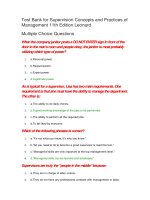Test bank business ethics concepts and cases chapter 21
Bạn đang xem bản rút gọn của tài liệu. Xem và tải ngay bản đầy đủ của tài liệu tại đây (89.29 KB, 4 trang )
1.
What principles backed up the positions of both sides in the Traidos Bank and Roche's
Drug Trials in China case? Which principle seems to be most correct in this situation?
Why?
2.
Utilitarianism characterizes the moral approach taken by Ford in the infamous Pinto case
study.
a.
True
b.
False
3.
Few businesses maintain that the socially responsible course to take is the utilitarian one
with the lowest net costs.
a.
True
b.
False
4.
Explain how the Ford cost-benefit analysis showed that it would not be right to fix the
exploding Pintos. Did the utilitarian analysis work, in this instance? Why or why not?
5.
What are the distinctions between traditional utilitarianism and rule utilitarianism? Why did
theorists come up with rule utilitarianism in the first place?
6.
Considerations to follow in determining what the moral thing to do might be are:
a.
You must determine what alternative actions are available.
b.
You must estimate the direct and indirect costs and benefits the action would produce for all
involved in the foreseeable future.
c.
You must choose the alternative that produces the greatest sum total of utility.
d.
All the above
e.
A&C
7.
Utilitarianism is attractive to many because it matches the views we tend to hold when
discussing governmental policies and public goods.
a.
True
b.
False
8.
Do Chinese workers have basic human rights that are different from those of American
workers? Do American companies have a duty to help protect those rights?
9.
What is the difference between a negative and a positive right? Which type of right is
more recent? Which type do liberals rather than conservatives most often propose? Why
might this be the case?
10.
Cost–benefit analysis is used to determine the desirability of investing in a project (such as a dam,
factory, or public park) by figuring whether its present and future economic benefits outweigh its
present and future economic costs.
a.
True
b.
False
11.
Major problems with the utilitarian reliance on measurement include:
a.
Comparative measures of the values things have for different people cannot be made; we cannot get
into each others' skins to measure the pleasure or pain caused.
b.
All benefits and costs are possible to measure.
c.
The potential benefits and costs of an action cannot always be reliably predicted.
d.
All the above
e.
A&C
12.
What are the ethical rules that govern contracts? Why is each of these rules necessary?
13.
What are the two formulations of Kant's Categorical Imperative? Kant argued that they
really said the same thing. Do you think that this is really the case? Explain.
14.
Intrinsic goods are things that are desired for their own sake, such as health and life.
a.
True
b.
False
15.
Rule utilitarianism looks only at moral rules of a particular action.
a.
True
b.
False
16.
What are the three categories of justice? How are they distinguished?
17.
What are the differences between Capitalist, Socialist, Fairness, and Libertarian
notions of justice? What are the strongest and weakest parts of each theory?
18.
Negative rights are defined entirely in terms of the duties others have not to interfere with
you.
a.
True
b.
False
19.
Immanuel Kant's principle, called the categorical imperative, requires that everyone be treated as:
a.
A free and equal person.
b.
A dependent employee.
c.
An indentured person.
d.
A non-resident employee.
20.
What are the principles behind the ethics of care? Was the owner of the Malden Mills
company really doing the right thing by rebuilding his factory and, at great cost, paying
his idle workers? Explain how his actions exemplify the principles of the ethics of care?
21.
Explain the "X-system" and "C-system" methods of discernment.
22.
UNOCAL worked with the Burmese army to push the pipeline using forced labor.
a.
True
b.
False
23.
UNOCAL agrees that it shares responsibility with the Burmese army over treatment of
pipeline citizens.
a.
True
b.
False
24.
Casuistry uses those previous clear cases to decide what is ethical in a new situation. It
requires us to decide whether the previous paradigm case was similar enough to our
current situation, then we make the decision how to make the decision.
a.
True
b.
False
25.
Roche can defend its use of harvested organs solely on the basis of ethical relativism.
a.
True
b.
False
26.
Rawls' Principle of equal liberty includes:
a.
Right to vote.
b.
Freedom of speech.
c.
Freedom of arbitrary arrest.
d.
All of the above.
e.
None of the above.
Test Name: chapter 2
1.
2.
3.
4.
5.
6.
7.
8.
9.
10.
11.
12.
13.
14.
15.
16.
17.
18.
19.
20.
21.
22.
23.
24.
25.
26.
a.True
b.False
d.All the above
a.True
a.True
e.A & C
a.True
a.True
a.True
a.A free and equal person.
a.True
b.False
a.True
b.False
d.All of the above.









